Silicone soap molds have become an indispensable tool in modern soap making, blending innovation with functionality. Whether you’re a novice or an experienced soap maker, understanding the nuances of these molds is crucial. This guide aims to address common challenges, offer solutions, and enhance your expertise in using silicone soap molds effectively.
What is a Silicone Soap Mold?
Silicone soap molds are a cornerstone in the world of soap making. But what exactly are they? Simply put, they are molds made from silicone, a flexible, rubber-like material known for its heat resistance and durability. This makes them a go-to choice for soap makers. Unlike traditional molds, silicone molds are soft and pliable, making it easier to release the finished soap without damage. They’re a perfect blend of functionality and innovation, catering to both the art and science of soap making.
Key Features:
- Flexibility: One of the most celebrated features of silicone molds is their flexibility. This means you can bend and twist them to easily pop out the finished soap, reducing the risk of breakage or imperfection in your final product.
- Non-Stick Surface: Silicone naturally has a non-stick quality. This means soap comes out smoothly, leaving behind minimal residue. This feature not only makes the demolding process a breeze but also simplifies cleaning.
- Durability: Silicone is remarkably durable. It withstands a range of temperatures and conditions, from freezing cold to oven hot, without losing its shape or quality. This resilience means your molds last longer, even with regular use.
- Versatile Use: Whether you’re making cold process soap, melt and pour soap, or even bath bombs, silicone molds are up to the task. Their ability to handle different soap-making processes makes them a versatile tool in any soap maker’s arsenal.
In essence, silicone soap molds are the unsung heroes of soap making. They bring ease and efficiency to the process, allowing soap makers to focus more on creativity and less on the logistical challenges of demolding and mold maintenance. Whether you’re a hobbyist experimenting in your kitchen or a professional producing large batches, silicone molds are an invaluable asset to your craft.
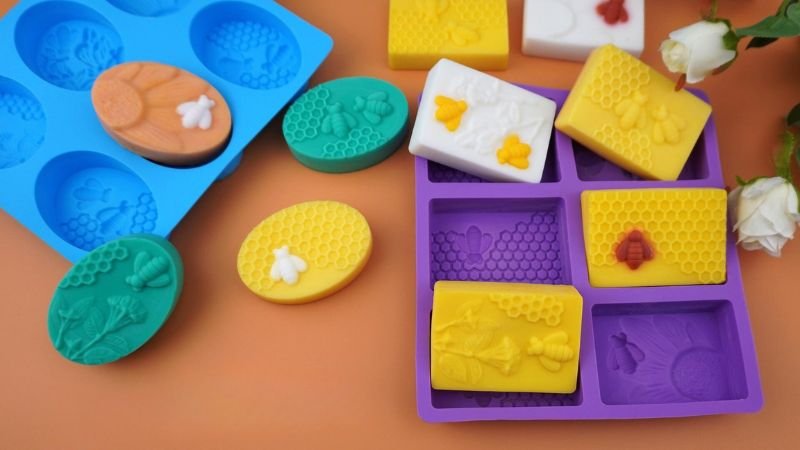
How to Choose and Use Silicone Soap Molds Effectively?
Selecting the right silicone soap mold is crucial for achieving desired results in soap making. The vast array of options available can be daunting, but focusing on your specific needs makes this task manageable. Look for high-grade silicone that is sturdy yet flexible. A good quality mold will not only last longer but also ensure a smooth release of your soap without any deformities.
Matching Molds to Your Soap-Making Technique
Different soap-making techniques require different types of molds. For instance, molds for cold process soaps should have thicker walls to withstand the heat generated during the saponification process. In contrast, molds for melt and pour soaps need to tolerate higher temperatures without warping.
Size and Shape Considerations
The dimensions and design of your mold directly influence the size and shape of your soap bars. Smaller molds are perfect for crafting sample sizes or guest soaps, whereas larger molds are suitable for standard or specialty bars. When considering the shape, think about the end user and the soap’s purpose – decorative, functional, or both.
Optimizing Mold Usage
Proper use and care of silicone molds not only extend their lifespan but also improve your soap-making efficiency. Avoid overfilling molds to prevent spillage and ensure even bars. After use, clean the molds with warm, soapy water and store them flat to maintain their shape. Avoid using sharp objects to remove soap, as they can damage the silicone surface.
By focusing on these critical aspects, soap makers can confidently select and utilize silicone soap molds that cater to their specific requirements, enhancing both the quality and the efficiency of their soap-making process.
Creative Soap Making with Silicone Molds: Step-by-Step Guide
Silicone molds are not just functional; they’re a gateway to creative soap making. With their diverse range of shapes and intricate designs, these molds allow you to transform a simple bar of soap into a work of art.
Designing Unique Soaps
Begin by selecting a mold that aligns with your vision. Whether you’re aiming for elegant floral patterns, fun shapes for kids, or clean and minimalist lines, there’s a silicone mold to suit your creative idea. Remember, the mold shape can add character to your soap, making it more appealing to customers or as a personal gift.
Step-by-Step Soap Making Process
- Preparation: Gather all your soap-making materials, including your chosen silicone mold, soap base, colorants, fragrances, and any additives.
- Melting the Base: If using a melt and pour method, gently melt your soap base in a double boiler or microwave, ensuring not to overheat.
- Adding Extras: Once melted, add your colorants, fragrances, and additives. Mix well but avoid creating too many bubbles.
- Pouring into Mold: Carefully pour the soap mixture into the silicone mold. Tap the mold gently to release any trapped air bubbles.
- Setting and Unmolding: Allow the soap to cool and harden completely before attempting to remove it from the mold. Silicone’s flexibility makes demolding simple and preserves the intricate details of your design.
Tips for Perfect Results
- Experiment with layers and embeds for a more complex and visually appealing soap.
- Maintain the correct pouring temperature to avoid issues like soap sweating or separation.
- Be mindful of fragrance and colorant usage rates to ensure the final product is skin-safe and aesthetically pleasing.
Embracing the versatility of silicone molds opens up a world of possibilities in soap making. Whether you’re crafting for business or pleasure, silicone molds can help turn your creative visions into tangible, delightful soaps.
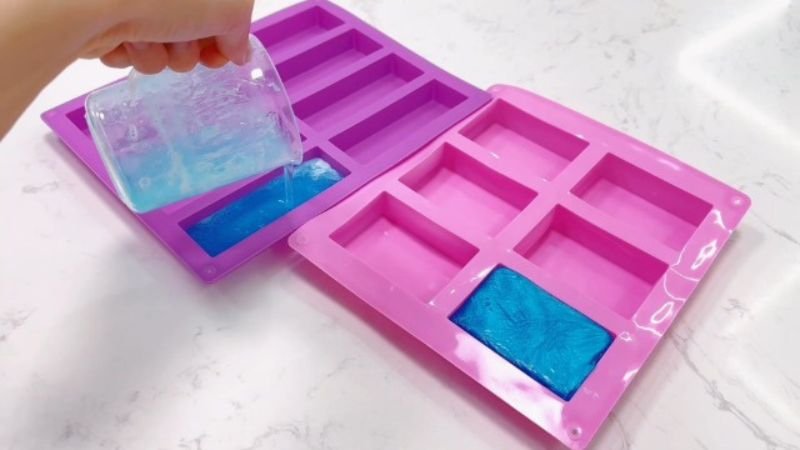
Silicone vs Other Materials: Which Soap Mold is Best for You?
When it comes to soap molds, the material can significantly impact your soap-making process and the quality of your final product. Silicone molds have gained popularity, but how do they stack up against traditional materials like wood or plastic?
Silicone Molds: The Modern Choice
- Pros: Silicone molds are celebrated for their flexibility, which allows for easy demolding. Their non-stick nature requires minimal to no release agents, and they’re durable, withstanding a wide range of temperatures.
- Cons: They can be more expensive upfront than other materials and might not offer the same rustic aesthetic that some soap makers prefer.
Wooden Molds: The Traditionalist’s Pick
- Pros: Wooden molds, often lined with silicone or parchment paper, give a classic look and feel to soap bars. They are excellent for insulation, particularly beneficial for cold process soaps.
- Cons: Wood requires more maintenance, including lining before each use and proper drying to prevent mold and warping.
Plastic Molds: The Economical Option
- Pros: Plastic molds are usually the most affordable. They are lightweight and available in various shapes and sizes.
- Cons: They lack the durability of silicone, are prone to scratches, and may not withstand high temperatures, limiting their reuse.
Making the Right Choice
Consider your soap-making method, budget, and personal preference in aesthetics when choosing a mold material. Silicone molds are versatile and user-friendly, making them an excellent choice for soap makers of all levels, especially those looking for ease of use and longevity. Wooden molds suit those who enjoy the traditional soap-making process and value the classic shape and insulation they offer. Plastic molds might be suitable for beginners or those making soap casually due to their lower cost.
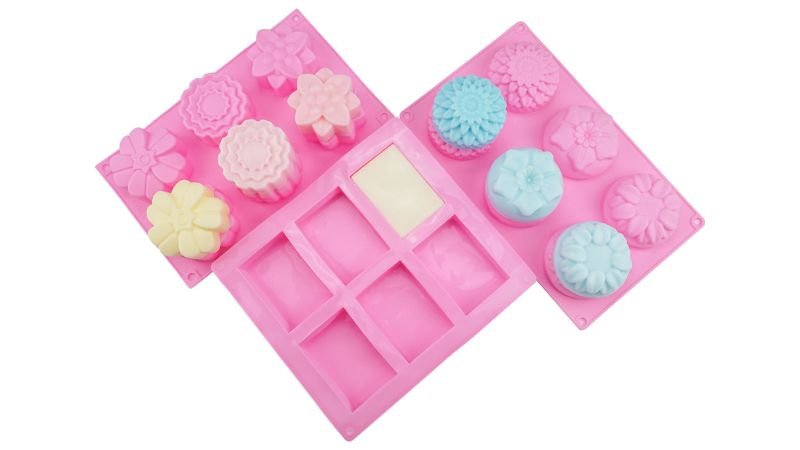
Eco-Friendly Benefits of Using Silicone Soap Molds
In an era where environmental consciousness is paramount, silicone soap molds present an eco-friendly option for soap makers.
Silicone Molds: A Greener Choice
- Durability and Reusability: One of the most significant eco-friendly aspects of silicone molds is their durability. Unlike single-use or less durable materials, silicone can be used repeatedly for years, reducing waste and the need for frequent replacements.
- Safe and Non-Toxic: Silicone is a non-toxic material that doesn’t contain harmful chemicals like BPA, lead, or PVC. This makes it a safer choice for both the environment and the end user.
- Energy Efficient Manufacturing: The production of silicone molds generally requires less energy compared to other materials like plastics, contributing to a lower carbon footprint.
Reducing Environmental Impact in Soap Making
- Long-Term Cost-Effectiveness: While the initial investment in silicone molds might be higher than other materials, their longevity and durability make them more cost-effective in the long run, reducing the environmental impact associated with frequent mold replacement.
- Recyclability: At the end of their life, silicone molds are recyclable, further contributing to their eco-friendly profile. Though silicone recycling is not as widespread as other materials, it is gaining traction as part of the growing focus on sustainability.
Making the Eco-Conscious Choice
As a soap maker, opting for silicone molds is a step towards more sustainable practices. Not only do these molds offer functional benefits like flexibility and ease of use, but they also align with the growing need to reduce our environmental footprint. By choosing silicone, soap makers can create beautiful products while upholding a commitment to environmental stewardship.
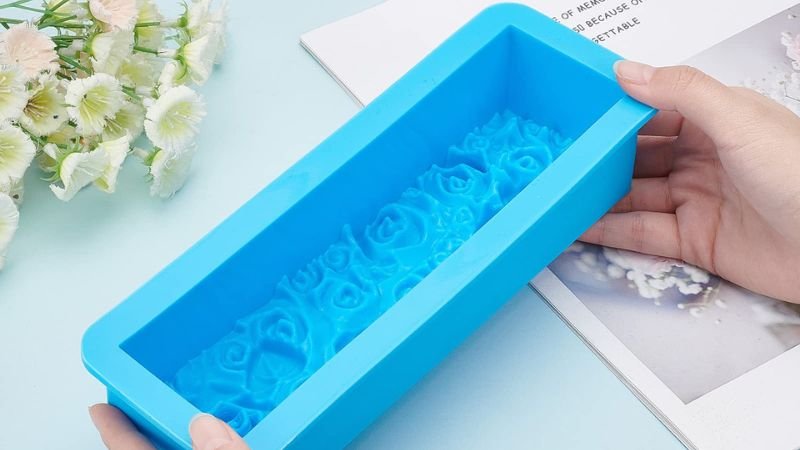
Cleaning and Maintenance of Silicone Soap Molds
The durability of silicone soap molds is one of their biggest advantages, but proper cleaning and maintenance are crucial to ensure they last for years.
Effective Cleaning Practices
- Regular Cleaning: After each use, clean the molds with warm, soapy water. Silicone is non-porous, which makes it resistant to stains and odors, but soap residue can build up over time.
- Gentle Approach: Use a soft cloth or sponge to clean the molds. Avoid abrasive scrubbers or harsh chemicals that could damage the silicone surface.
- Thorough Drying: After washing, dry the molds completely before storing. While silicone is mold-resistant, any leftover moisture can create an environment for mildew, especially if molds are stored in a closed space.
Proper Storage for Prolonged Life
- Flat Storage: Store silicone molds in a flat position to prevent them from bending or warping. Storing them in a distorted shape can lead to uneven soap bars in the future.
- Avoid Direct Sunlight: Store your molds in a cool, dry place away from direct sunlight. Prolonged exposure to UV rays can degrade silicone over time.
Periodic Inspection
- Check for Damage: Regularly inspect your molds for any signs of wear and tear, such as cracks or brittleness. Even the highest quality silicone can degrade after extensive use.
- Replacement Considerations: If a mold starts showing signs of significant wear, it might be time to replace it to ensure the quality of your soap bars is not compromised.
Maximizing Mold Usability
By following these simple care and maintenance guidelines, you can significantly extend the life of your silicone soap molds. Properly maintained molds not only ensure a consistent quality in your soap production but also contribute to cost efficiency and environmental sustainability by reducing the need for frequent replacements. Remember, a little care goes a long way in preserving the quality and effectiveness of your silicone soap molds.
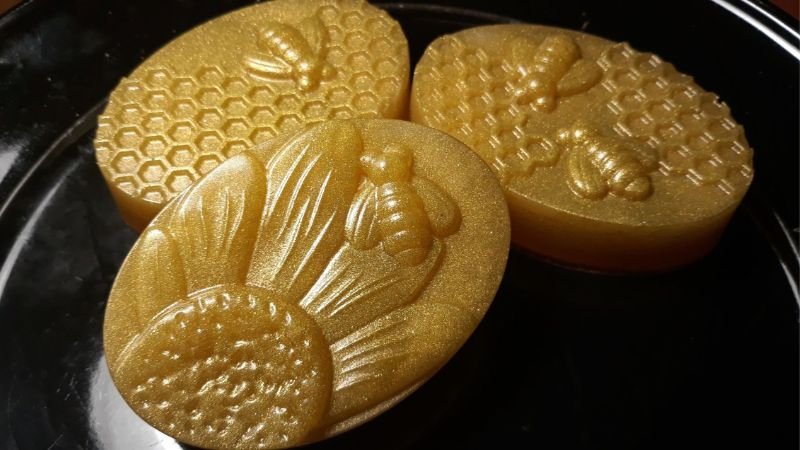
Maximizing Business Potential with Custom Silicone Soap Molds
Custom silicone soap molds are more than just a tool for soap making; they are a means to distinguish your brand in a competitive market.
Customization as a Marketing Tool
- Brand Logo and Unique Shapes: Custom molds can feature your brand logo, unique shapes, or specific designs that align with your brand identity. This personalization makes each soap bar an ambassador of your brand, enhancing brand recognition and loyalty.
- Creating Exclusive Designs: Offer limited edition soaps or special collections using custom molds, creating exclusivity that attracts customers and sets your products apart from competitors.
Working with Manufacturers for Custom Molds
- Design Collaboration: Partner with mold manufacturers who offer customization services. This collaboration can involve 3D design mockups to ensure the final product meets your expectations.
- Quality and Detail Consideration: Ensure the manufacturer understands the level of detail and quality you expect. The precision in custom molds is crucial for replicating intricate designs and maintaining consistency across batches.
Cost-Benefit Analysis
- Investment vs. Return: Custom molds require a higher initial investment. Conduct a cost-benefit analysis to determine the potential return on investment, considering factors like increased sales due to unique product offerings and enhanced brand visibility.
- Long-Term Value: Custom molds can provide long-term value by solidifying your brand’s presence in the market and facilitating customer loyalty.
Conclusion
Incorporating custom silicone soap molds into your production line is a strategic move that can lead to significant business growth. By offering unique and personalized products, you not only cater to your customers’ preferences but also establish a distinctive brand identity in the soap-making industry. Custom molds represent an intersection of creativity and marketing, a powerful combination for any business looking to make its mark.